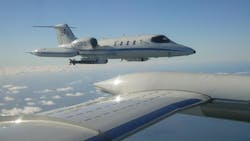Braunschweig, Germany--The Physikalisch-Technische Bundesanstalt (PTB) has developed a laser-based humidity sensor—the Selective Extractive Airborne Laser Diode Hygrometer (SEALDH)—that has proven its worth when used aboard an aircraft by fulfilling all pre-conditions to be used as a transfer standard for conventional humidity measuring instruments. The release says that this hygrometer will allow the quality of air humidity measurements (http://www.laserfocusworld.com/articles/2012/01/dial-in-the-alps-measures-tropospheric-water-vapor.html) in the Earth's atmosphere—and thus, also climate model computations—to be improved. The work is detailed in Applied Physics B; complete citation is B. Buchholz et al., Applied Physics B 110, 2, 249-262 (2013).
Humidity measurements in the atmosphere are of essential importance, since water vapor, as the most important natural greenhouse gas, has a strong influence on the Earth's atmospheric radiation balance and, therefore, decisively influences our climate. In addition, water is responsible for meteorological phenomena such as the formation of clouds and precipitation. Hence, the atmospheric water content is an essential measurand in all climate models, but also when it comes to forecasting the weather; this water content must be determined with great accuracy if reliable predictions are to be made with regard to the weather and to the development of the climate.
However, measuring water vapor (http://www.laserfocusworld.com/articles/2011/05/cavity-ringdown-spectroscopy-icos-isotope-ratio-measurement-sheds-new-light-on-climate-change.html)—especially into the upper atmosphere—is not easy; humidity measurements differ sometimes by more than 10 % when measured in different research projects, using alternative methods, even within the scope of demanding laboratory comparisons. In order to improve the quality of atmospheric water vapor measurements and to provide better comparability, PTB scientists have developed the traceable laser hygrometer SEALDH, which works according to the principle of tunable diode laser absorption spectroscopy (TDLAS). Its use aboard an aircraft requires the system to be small, light and insensitive to vibrations; in addition, it must be able to perform rapid measurements and to work autonomously; that is, to constantly monitor itself or to be able to resume operation itself after a fault after an unplanned shutdown. SEALDH is also self-calibrating. This is a clear advantage compared to conventional hygrometers that have to be calibrated frequently--and often under adverse conditions like in an airplane hangar.
SEALDH has now been tested under field conditions within the scope of a scientific mission on a Learjet 35A, a former passenger plane that was adapted for research purposes; it was able to give proof of its performance during seven flights after having passed a blind comparison with several established aircraft hygrometers at the environmental simulation chamber of Forschungszentrum Jülich. During its in-flight operation, the laser hygrometer proved a detection limit in the ppm range, a very large measuring range between 25 ppm and 25,000 ppm of water volume fraction, as well as an excellent temporal resolution below 1 s.
Furthermore, PTB scientists have compared SEALDH with PTB's national humidity standard and attained a mean deviation of less than 2% without prior calibration. Based on these features, it will, in the medium term, be possible to use SEALDH as a transfer standard for the quality assurance of air humidity measurements in atmospheric research.
SOURCE: Physikalisch-Technische Bundesanstalt (PTB); http://www.ptb.de/en/aktuelles/archiv/presseinfos/pi2013/pitext/pi130225.html

